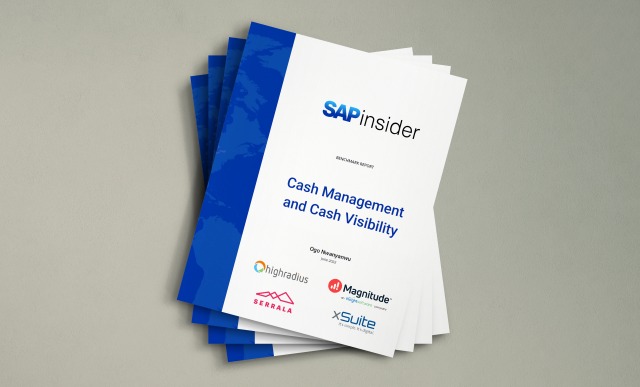Bob Stark Highlights Critical Real-Time Data and Cash Visibility Lessons
Meet the Authors
Key Takeaways
⇨ The value of visibility is only in what actions that you can initiate because of it.
⇨ When migrating to S/4, organizations should reexamine processes that may be built around an older implementation to enable real-time data.
⇨ Real-time data enables decision-makers, such as CFOs, to answer questions pertaining to the financial health of their organizations with actionable information.
Findings from SAPinsider’s SAP S/4HANA Finance and Central Finance benchmark research shows that the demand for insights, reporting, planning and visibility from finance, including treasury teams, continues to be the number-one driver of how organizations are thinking about their strategic investments with regard to technology and automation in areas like cash management and treasury, planning, and forecasting.
Coming out of the pandemic, organizations wanted to enhance these areas, but we see that they still have some more work to do.
SAPinsider Research Director Ogo Nwanyanwu recently spoke with Bob Stark, Global Head of Market Strategy at Kyriba, to discuss his insights on data management strategy. The transcript covering that part of the discussion with Bob Stark follows:
Explore related questions
Ogo Nwanyanwu:
What were some of the success stories or some of the positive impacts that customers have shared with regards to working with Kyriba and your solution portfolio?
Bob Stark:
One theme that is transversal across everything that we’ve been talking about is having a data strategy and being able to harness unified data across your enterprise. And that obviously includes capturing information and being able to navigate through the analytics that SAP offers and being able to then turn that into actionable information. When we talked about things like cash forecasting, you really want to make that cash forecast actionable. Visibility is wonderful. We all want visibility into cash, we want visibility into bank balances, we want visibility into risks or bank fees or any of those things.
We need to be able to drive action out of that visibility. The value of visibility is really only in what it enables. It’s the actions that you can initiate as a result of having visibility or insight is what’s critical when it comes to treasury to be very precise that actionability is being able to do something with your forecast.
With Silicon Valley Bank, that was a big concern of many organizations. Do I have enough cash flow? Do I still have access to my cash flow? Can I move it? Those were generally the questions that most people were looking for. Once everyone was reassured that everything was stable, many organizations were looking at, “Well, what happens next?”
Data is what drives all of those decisions, and it’s a matter of unifying data across your different platforms. There’s a tremendous amount of information within SAP, as an example, that for organizations that are using our platform, that’s critical to their ability to forecast and plan for cash and liquidity, being able to protect themselves against say, currency volatility, being able to just do simple things like initiate payments and ensure that those are compliant, meeting their internal governance, and protected from things like fraud, which I know is a whole different conversation than what we’ve been speaking about, but it’s all incredibly important and it’s all data-centric.
The key to all of this is that it’s not just the presence of data—it’s the need to consume and learn from that in real time and then act on that information. Holistically, that’s the theme that every practice, every capability, every feature that provides automation, it’s all-around finding ways to make use of more data to drive better, more data-driven decisions. And I know I used data twice in that last sentence—that was intentional because it’s just that important. There are a variety of examples, and I can go through a few of them. Maybe just I’ll touch on maybe a couple just as examples.
Many organizations that come to us within the SAP community, they’re coming to us quite often because they’re going through, say, a migration to S/4, and they’re coming off of more an installed environment or private cloud and going more to, let’s just say, a proper SaaS environment.
One of the things that they’re looking for is complete automation end-to-end for the payments workflows. So that payment process, you can envision what that looks like from SAP. You’re initiating, let’s just say it’s accounts payable. You’re initiating those payments, you’re looking to run all sorts of compliance checks. And those compliance checks could be sanction list screening, if that’s something you don’t want to rely on your bank for. It could be bank account validation, it could be some level of compliance. Is this payment within our policy, or is it an exception? Typically, there’s a lot of different checks. Is it a suspicious payment? Is it typical for how we’ve sent payments? All sorts of, we’ll just say checks and balances to ensure, yes.
And then obviously once it is seen as valid and approved in terms of your audit and controls, then it’s a matter of formatting it out to whatever the bank needs to see and driving it typically via API, sometimes via other means, depending on the bank institution, the payments we’re talking about. That whole process needs to now run at machine speed.
The example is that when you’re migrating, say to S/4 or any instance of SAP, you are very much expecting that this is an automated end-to-end process. But, you’re not necessarily expecting and realizing this needs to run at machine speed—and it can’t be belabored by having a 30-minute check process to validate whether this payment is in compliance or outside of our governance structure.
People expect that they can detect fraud in real time because their payments are being sent in real time. They expect that whatever the bank needs to see in terms of format and consent can be done, and in terms of controls can be done in real time. And even just the simple things like, “Is this the organization that I think I’m paying? Does this bank account actually belong to the beneficiary I’m running a payment to?” Again, you’re expecting this stuff to happen in real time.
That’s one of my favorite examples for SAP customers, because oftentimes when you’re migrating to the S/4, you will find that whatever process you had before was a construct that may be built around an older implementation. And it needs to be opened up and looked at and modernized for the types of payments and the speed at which this data is consumed effectively in real time, which wasn’t a requirement when maybe the last iteration of SAP was implemented for the organization.
Ogo Nwanyanwu:
You talk about the real-time data and its importance to this process. According to previous research on this topic, more than seven out of 10 SAPinsiders said deep integration of cash management and treasury processes with their ERP for seamless real-time data exchange was extremely critical to their strategic priorities for achieving cash visibility. It aligns with what you’re saying in terms of that data and that end-to-end automation and flow through process with regards to the treasury function.
Bob Stark:
Yeah, I fully agree with those observations; we live and read that every day. It is so critical for an organization to, as I said before, it’s not just visibility, that system integration to be actionable. What you’re expecting is that I need to know at any point in time what my cash is, and what my ability to raise cash is, or improve cash to meet things like free cashflow targets that the CFO and CEO probably talked about on an earnings transcript.
Those earnings calls that are transcribed, people are saying, “This organization is expected to generate this much cash.” You need to be able to have that integration across your ecosystem, across basically all the accessories that plug into SAP to ensure, “Yes, I can meet those targets and here’s the way I’m going to do it.”
Sometimes it’s as simple as optimizing DPO. Maybe I’m going to extend my payables terms, maybe I’m going to implement some supplier financing program to be able to pay later, but not at the expense of my suppliers. Maybe I’m going to accelerate receivables and improve my DSO. Maybe I’m going to optimize the way that we invest in inventory.
These are levers that CFOs and treasurers want to pull, but they need instant visibility to know what’s the impact If I do this, do I even need to do this? What’s my ability to borrow? How much more expensive did it get to borrow now that interest rates have continued to climb? Can I run a netting program? Can I run an in-house bank or cash pool that’s going to optimize some of the borrowing and investing I do, so that I can actually free up some cash flow and optimize my liquidity from an internal perspective, never mind having to work within our value chain?
These sorts of questions, as you rightly say, they are answered by data in real time and it’s a critical need for any business as they look to modernize and make themselves more efficient.
[Editor’s note: The end of the second part of the conversation focuses on data. The first part of the conversation that focused on key lessons from the SVB fallout can be found here. This interview has been edited and condensed.]
Many organizations are working to gain more data and real-time insights into their business processes. But the data is only useful if it is leveraged to make better decisions. It is vital that SAP users unify all data across their system to provide a holistic picture of their business. That way, they can avoid disruption, minimize risk, and set their organization up for success.
Make sure to download and read our AP Invoice Management Benchmark Report and our Cash Management and Cash Visibility Benchmark Report, available for all members of the SAPinsider Community.
Please take our Intelligent Finance in the Cloud survey to share your insights on intelligent automation and see where you stand against your peers.





